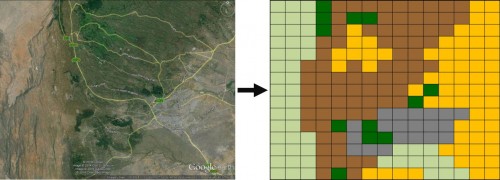Animals move across the landscape for many reasons – such as migration, dispersal, or simply to find enough food. These movements often force animals to move through less-than-ideal habitat where they’re more exposed to predators or dangers associated with human activity (think of a deer moving out of a forest to cross a highway). Because not all habitats making up a landscape are the same, there are often more- and less-costly paths an animal can take as it moves from one point to another. In this lesson students will explore the costs of moving across a complex landscape. The students’ goal is to find the least-cost (i.e. safest) path for a particular animal given knowledge of that animal’s habitat needs and preferences and the dangers associated with different habitats.
At the conclusion of the lesson, students will be able to:
- Explain how habitats, humans, and other wildlife can affect an animal’s ability to move across a landscape.
- Describe negative impacts that human land-use practices have on wildlife and predict the consequences of future land-use change.
- Discuss and compare the habitat requirements of some East African wildlife.
Resources:
Lesson Plan created by GK-12 Fellow Andy Booms and Partner-Teachers Jamie Bowman and Shaun Davis, 2014

